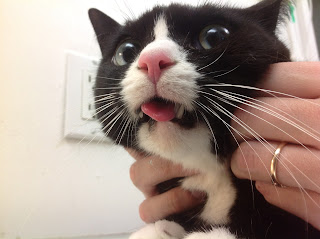Cats Rule... and Drool!
Recently, I was presented with an 8 year-old cat with a relatively sudden onset of drooling. The owner said that her cat, Lulu, would sit with her mouth open and her tongue sticking out a little bit, and there would occasionally be some saliva coming from the cat’s mouth. Every now and then, she said, the cat would shake her head, and some saliva would come flying out. I asked if the cat was able to eat and drink, and she said yes, this was no problem. I asked if she thought the cat was having any pain or discomfort with the teeth, and she said she didn’t think so, because years ago the cat had most of her teeth extracted because of severe dental disease. There were really not many teeth left to be causing any problems, she thought. There were just the four big canine teeth left, as well as a few tiny little incisors.
I took a look at Lulu.
Sure enough, as she sat on the table, her mouth was open a little bit, and her tongue protruded a
little.
Lulu only had a few teeth left, mostly the canines.
You can see that her left upper canine (on the right side of the photo)
has shifted. Normally, the upper canine
is positioned laterally to the lower canine on that same side. Lulu’s left upper canine has shifted
medially, affecting the way the
teeth mesh. This abnormal bite is called malocclusion. Why did the tooth shift? If you look at the top of the tooth, you can see the yellow tartar at the gum line,
with a little bit of pus. Notice how the
gums above the tooth are red and swollen.
This is severe periodontal disease. The tooth was loose, and it was
painful for the cat when the tooth was touched.
Normally, we like to schedule our dental procedures in the
mornings, in advance. But poor Lulu was uncomfortable, and this couldn’t
really wait. After some quick blood and
urine tests, Lulu was taken back to our treatment room, anesthetized, and that
loose, diseased tooth was extracted. Her
right upper canine was diseased as well,
although not as badly as the left one.
It, too, needed to be extracted.
A few years ago, I wrote an article entitled “When Cats Drool”. I decided to write it because I
had never seen an article specifically on drooling, and I thought the uniqueness of the topic would make it
appealing. It turns out that of all the
articles I’ve written, the drooling article get the most hits. In the article, I distinguish between true
ptyalism (increased production of
saliva) and pseudoptyalism (the cat is making a normal amount of saliva, but can’t keep it inside the mouth
because the mouth cannot close
properly). Lulu is a great example of
pseudoptyalism.
Lulu is at home now and is doing well. Even though she now has even fewer teeth
(maybe four total, in her entire head), she is obviously prone to dental
problems, and we’re going to have to keep an eye on those few remaining teeth,
to make sure the same thing doesn’t happen again.



Ouch! I'd be drooling too. My cat has a broken canine that our vet and I keep an eye on. He said to watch for the tooth to darken or the gum to get red. At that time we'll need to pull her tooth. Hopefully this happens slowly I catch it before it looks like Lulu's painful tooth.
ReplyDeleteWas the cat diagnosed with feline leukemia? I had a male who was born with feline leukemia. Although he managed to live 13 years, at the end his teeth were getting infected and coming loose. Broke my heart when he died.
ReplyDelete